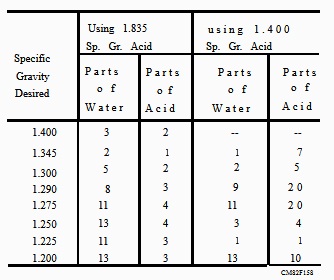Some gassing will occur while you are filling the battery due to the release of carbon dioxide that is a product of the drying process of the hydrogen sulfide produced by the presence of free sulfur. Therefore, the filling operations should be in a well-ventilated area. These gases and odors are normal and are no cause for alarm.
Approximately 5 minutes after adding electrolyte, the battery should be checked for voltage and electrolyte strength. More than 6 volts or more than 12 volts, depending upon the rated voltage of the battery, indicates the battery is ready for service. From 5 to 6 volts or from 10 to 12 volts indicate oxidized negative plates, and the battery should be charged before use. Less than 5 or less than 10 volts, depending upon the rated voltage, indicates a bad battery, which should not be placed in service.
If, before placing the battery in service, the specific gravity, when corrected to 80F, is more than .030 points lower than it was at the time of initial filling or if one or more cells gas violently after adding the electrolyte, the battery should be fully charged before use. If the electrolyte reading fails to rise during charging, discard the battery.
Most shops receive ready-mixed electrolyte. Some units may still get concentrated sulfuric acid that must be mixed with distilled water to get the proper specific gravity for electrolyte.
MIXING ELECTROLYTE is a dangerous job. You have probably seen holes appear in a uniform for no apparent reason. Later you remembered replacing a storage battery and having carelessly brushed against the battery.
WARNING
When mixing electrolyte, you are handling pure sulfuric acid, which can burn clothing quickly and severely bum your hands and face. Always wear rubber gloves, an apron, goggles, and a face shield for protection against splashes or accidental spilling.
When you are mixing electrolyte, NEVER POUR WATER INTO THE ACID. ALWAYS POUR ACID INTO WATER. If water is added to concentrated sulfuric acid, the mixture may explode or splatter and cause severe burns. Pour the acid into the water slowly, stirring gently but thoroughly all the time. Large quantities of acid may require hours of safe dilution.
Figure 2-5 shows you how much water and acid to mix for obtaining a certain specific gravity. For example, mixing 5 parts of water to 2 parts of acid produces an electrolyte of 1.300, when starting with 1.835 specific gravity acid. If you use 1.400 specific gravity acid, 2 parts water and 5 parts acid will give the same results.
Let the mixed electrolyte cool down to room temperature before adding it to the battery cells. Hot electrolyte will eat up the cell plates rapidly. To be on the safe side, do not add the electrolyte if its temperature is above 90F. After filling the battery cells, let the electrolyte cool again because more heat is generated by its contact with the battery plates. Next, take hydrometer readings. The specific gravity of the electrolyte will correspond quite closely to the values on the mixing chart if the parts of water and acid are mixed correctly.
Battery Maintenance
If a battery is not properly maintained, its service life will be drastically reduced. Battery maintenance should be done during every PM cycle. Complete battery maintenance includes the following:
Visually checking the battery.
Checking the electrolyte level in cells on batteries with caps. Adding water if the electrolyte level is low.
Cleaning off corrosion around the battery and battery terminals.

Figure 2-5. - Electrolyte mixing chart.
Continue Reading